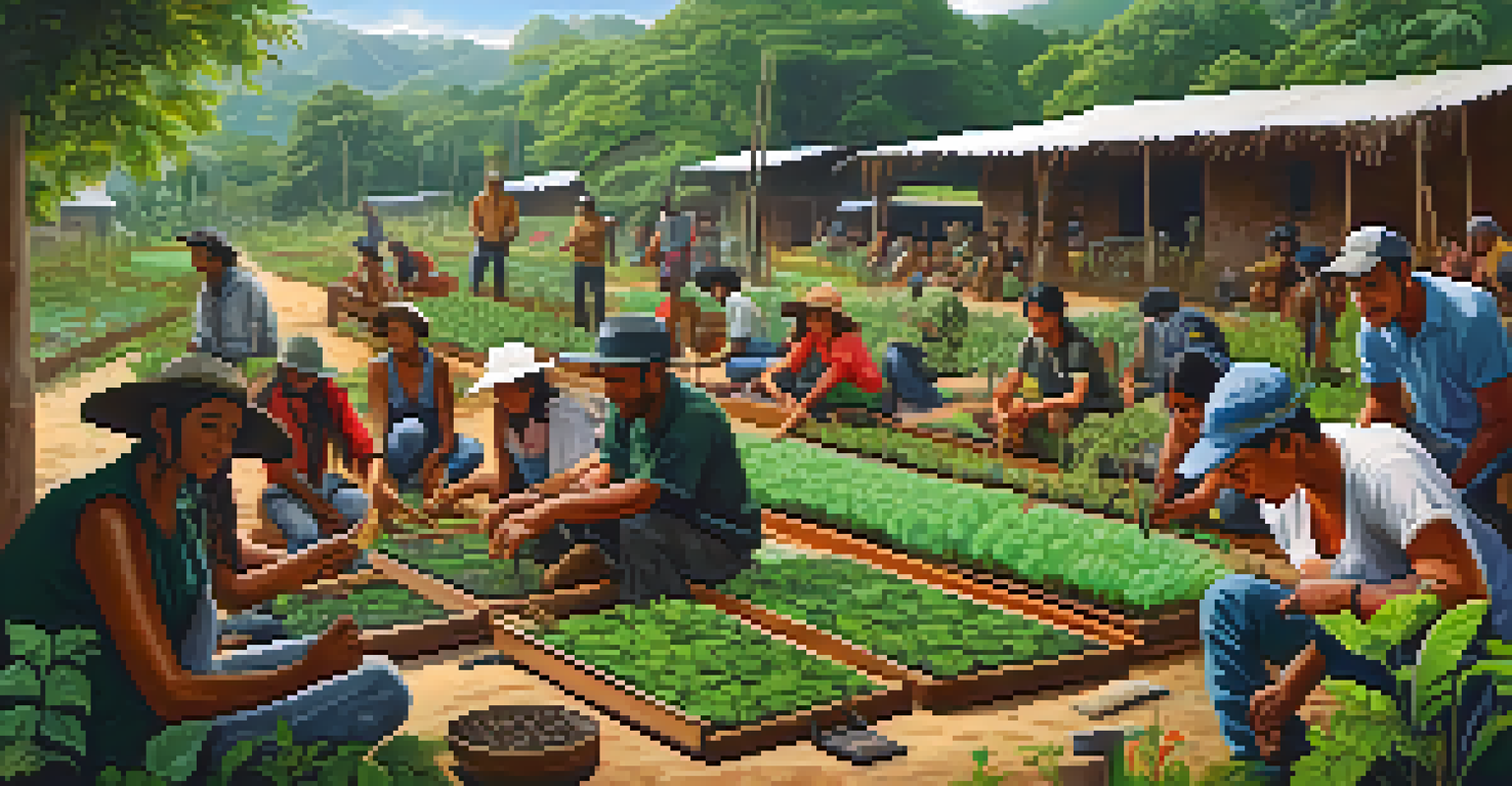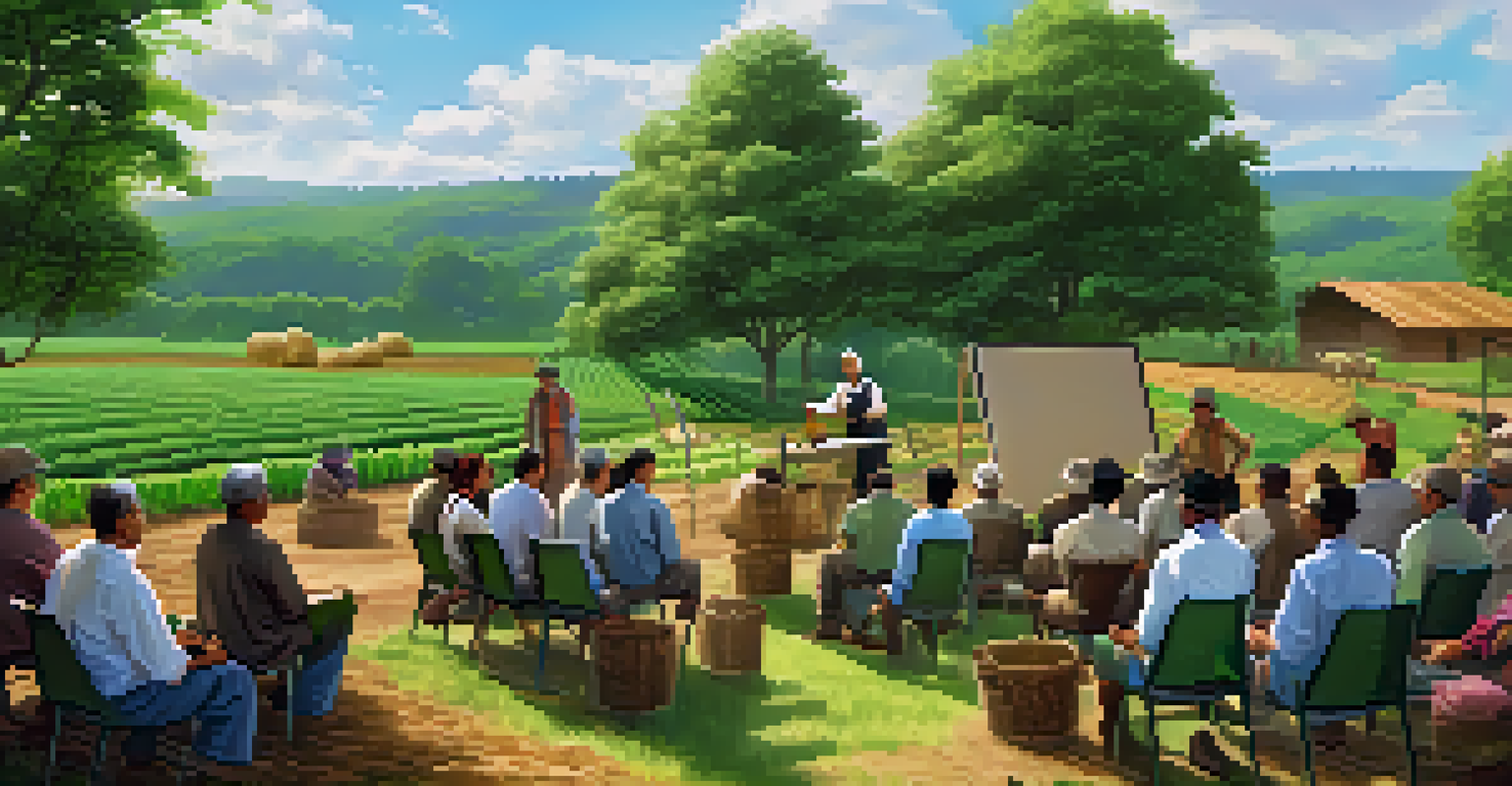Community Education on Sustainable Ayahuasca Cultivation Practices

Understanding Ayahuasca and Its Cultural Significance
Ayahuasca is a traditional Amazonian brew made from the Banisteriopsis caapi vine and other plants. It has deep cultural roots, often used in spiritual ceremonies and healing practices by indigenous communities. Understanding its significance helps frame the conversation around sustainable cultivation and preservation of both the plant and its cultural heritage.
In every walk with nature one receives far more than he seeks.
The brew is not just a hallucinogenic experience; it's a doorway to spiritual connection and insight for many users. As interest in ayahuasca grows globally, it is crucial to respect its origins and the communities that have safeguarded its traditions for centuries. This respect forms the foundation for discussions about sustainable practices.
Moreover, the rise of tourism related to ayahuasca has put pressure on natural resources. This highlights the importance of educating both practitioners and consumers about sustainable cultivation methods that honor the plant’s cultural context while ensuring its availability for future generations.
The Importance of Sustainable Cultivation Practices
Sustainable cultivation practices are essential to protect ayahuasca's natural habitats and ensure a healthy ecosystem. Overharvesting and unsustainable farming techniques can lead to the depletion of vital plant species, affecting both biodiversity and cultural practices. By adopting sustainable methods, communities can safeguard their resources while also providing for their economic needs.

These practices include organic farming, agroforestry, and intercropping, which not only improve soil health but also enhance the resilience of the ecosystem. For example, planting ayahuasca alongside other native plants can create a more balanced environment that supports various species. This approach not only benefits the plants but also the communities that rely on them.
Cultural Significance of Ayahuasca
Ayahuasca is deeply rooted in Amazonian culture, serving as a vital tool for spiritual connection and healing among indigenous communities.
Educating local farmers about these practices is crucial. Workshops and community gatherings can help spread knowledge about sustainable techniques, enabling farmers to share experiences and learn from one another. This collective effort fosters a sense of community and responsibility toward preserving their cultural and natural heritage.
Educational Initiatives for Local Farmers
Implementing educational programs for local farmers is vital for promoting sustainable ayahuasca cultivation. These initiatives can provide hands-on training in sustainable agricultural practices, ensuring farmers are equipped with the knowledge they need to cultivate responsibly. By focusing on local resources and techniques, these programs can empower communities to thrive while respecting their environment.
The greatest threat to our planet is the belief that someone else will save it.
Furthermore, these educational efforts can involve creating partnerships with environmental organizations that specialize in sustainable agriculture. These collaborations can bring expertise and resources to communities, enhancing the effectiveness of education programs. Workshops can cover topics like soil management, pest control, and organic fertilizers, making sustainable practices accessible and practical.
Additionally, engaging the youth in these educational initiatives can cultivate a sense of stewardship for the environment. By involving young people in sustainability efforts, communities can inspire the next generation to continue the tradition of responsible ayahuasca cultivation and preserve their cultural heritage for years to come.
Community Workshops on Sustainable Practices
Community workshops are a fantastic way to bring people together to learn about sustainable ayahuasca cultivation. These gatherings can serve as platforms for sharing knowledge, experiences, and techniques that promote ecological balance. By fostering a collaborative environment, participants can benefit from one another's insights and develop a shared commitment to sustainability.
Workshops can feature guest speakers, local farmers, and experts in sustainable agriculture who can share best practices and innovations. This not only enriches the learning experience but also validates local knowledge and traditions. Participants can engage in hands-on activities, such as planting or maintaining ayahuasca gardens, making the learning process interactive and impactful.
Need for Sustainable Practices
Sustainable cultivation methods are essential to protect ayahuasca's natural habitats and ensure the longevity of both the plant and its cultural heritage.
Moreover, these workshops can help raise awareness about the challenges facing ayahuasca cultivation, such as climate change and market pressures. By discussing these issues collectively, communities can brainstorm solutions and develop action plans that support sustainable practices. This proactive approach fosters resilience and unity among community members.
Role of Technology in Sustainable Cultivation
Technology can play a significant role in promoting sustainable ayahuasca cultivation practices. Innovative tools and methods can enhance traditional farming techniques, making them more efficient and environmentally friendly. For example, using mobile apps for monitoring soil health or weather patterns can help farmers make informed decisions about their crops.
Additionally, technology can facilitate the sharing of knowledge across communities. Online platforms can host forums where farmers share their experiences and solutions to common challenges. This connectivity allows for a broader exchange of ideas and innovations, ultimately leading to improved practices and outcomes in ayahuasca cultivation.
However, it's essential to balance technology with traditional knowledge. While new tools can offer valuable insights, they should complement rather than replace the wisdom passed down through generations. Encouraging a dialogue between tradition and innovation can lead to more sustainable practices that honor both the land and its cultural significance.
Building Partnerships for Sustainable Impact
Building partnerships with various stakeholders is key to fostering sustainable ayahuasca cultivation practices. Collaboration with governmental organizations, NGOs, and academic institutions can provide resources and support for local communities. These partnerships can facilitate access to funding, training, and research, amplifying the impact of educational initiatives.
Moreover, involving local businesses in these partnerships can create economic incentives for sustainable practices. For instance, eco-tourism ventures can promote responsible ayahuasca experiences, encouraging visitors to engage with the community while respecting their traditions. This symbiotic relationship can lead to a sustainable income source for communities while preserving their cultural practices.
Education Empowers Local Farmers
Educational initiatives and community workshops can equip local farmers with sustainable practices, fostering a sense of responsibility towards their cultural and natural environment.
Creating a network of support not only strengthens the community but also raises awareness about the importance of sustainability in ayahuasca cultivation. By showcasing successful partnerships and initiatives, communities can inspire others to adopt similar practices, ultimately contributing to a broader movement towards sustainability in the ayahuasca industry.
The Future of Ayahuasca and Sustainable Practices
The future of ayahuasca cultivation hinges on communities' commitment to sustainability and education. As awareness of the ecological and cultural significance of ayahuasca grows, so does the potential for developing practices that honor both. Emphasizing sustainable methods can ensure that future generations have access to this powerful plant and the cultural traditions surrounding it.
Moreover, as global interest in ayahuasca continues to rise, communities can leverage this attention to advocate for responsible consumption and cultivation practices. By educating both tourists and practitioners about the importance of sustainability, communities can create a ripple effect that promotes ethical practices beyond their borders.

Ultimately, the goal is to create a future where ayahuasca is cultivated in harmony with nature and its cultural roots. This vision can be achieved through ongoing education, community engagement, and collaborative partnerships, ensuring that ayahuasca remains a source of healing, connection, and cultural pride for generations to come.